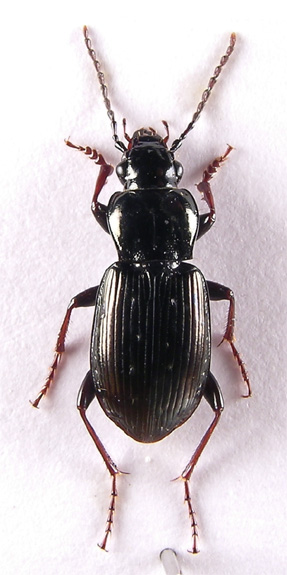
Male
9.5-12.6mm. Very shining black with faint metallic lustre, brassy or rarely bluish or greenish. Tibiae, tarsi and palpi brown, usually dark. Eyes prominent, two supra -orbital punctures on inside margin. Mandibles long and sharp, symetrical, but not so developed as in Stomis. Antennae pubescent from 4th segment, 1st slightly shorter than third (P.angustatus Duft). Basal segments without keel dorsally (Poecilus spp.). Pronotum glabrous and impunctate but for area around basal depression. Base almost straight to sharp hind angles, sides sinuate and bordered (almost) to front angles (P.adstrictus Esch.), with a single elongate and rugosely punctate basal fovea. Elytra a little less shining than pronotum, with epipleurs crossed and usually four small fovea joining stria 2 or 3, sometimes more, up to seven. With complete shoulder stria and scutellar stria obvious. Apex of first stria with three small setiferous punctures (angustatus Duft.). Legs long and stout, tibial spurs well developed. Tarsal segments smooth and glabrous above, without furrows. Claws smooth (cf. Calathus).
� But Hyman and Parsons state "All types of soil".
Description from 1 Watford Specimen at X20
Home